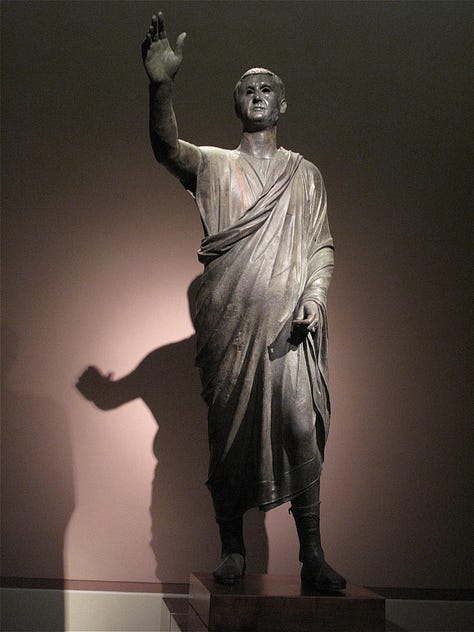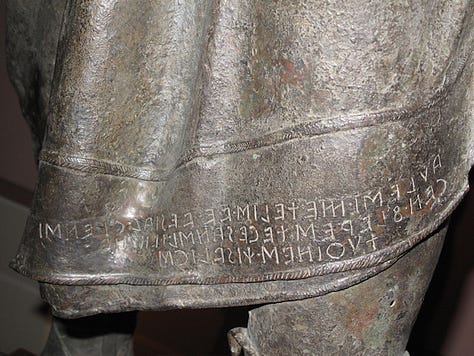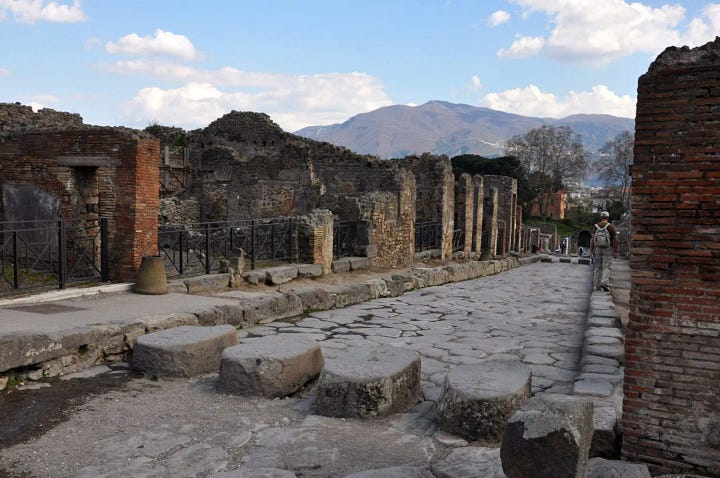Fresh Batch #103: The Destruction of Pompeii
And the Mythology of the Caesars, As, Aes, Asgard, Aesus, Esar, Aesir, Odin, Vidar, and Aeneas

Very few people observe the significance of the name Pompeii. The etymology of the name Pompeii is uncertain; suggestions are offered by modern “scholars” who aren’t of Etruscan or Italian descent, and who try to make it conform to Greek.


But sure as anything, its spelling conforms to a Latinized version of Etruscan cities, the pattern that scholars have not yet figured out with certainty, which is the plurality of the name, seen in cities like Veii, Tarquinii, Volsinii, Vulci, Falerii, Podium Bonitii, etc. Latin names for Etruscan towns also terminate in -ae, another form of plurality, seen in Volaterrae, Ripa Arranciae, Careiae, Figulinae, Fregenae, Orclae, Pistoriae, Rusellae, and Faesulae. It is equivalent to calling these locations by the people’s names, i.e., the Veians, the Tarquinians, Volsinians, Vulcians, etc., or in other words, it’d be like calling America Americans.
The Sarnus (Sarno) river grants sea-people easy access to Pompeii. The root of this word is Sar, rock, lord, also seen in Tyr, Tur, Tsar, Sur, Sir, and Tyre, the significance of which will be revealed in the members portion of this article.


What is my point? Pompeii was an important site going back to the Etrusco-Phoenician maritime empire, a critical location that a region can’t afford to lose without suffering substantial economic decline and social strife. The following is significant to my suspicion of Italy’s history being covered up by the Church because it is an Etruscan in Roman clothing, dated to the 1st century BC. This demonstrates that the Etruscan language was used at least till the time of Julius Caesar, whose last name is Etruscan. I suspect the mythology of the Caesars and their legendary history is not true, but a fabrication of the Church (or other variations of the priest class leading up to the formation of the Church), and the real history of Italy that has been destroyed and covered up is that of an Etrusco-Phoenician one.



According to Dr. Jeffrey A. Becker, “The lower hem of the short toga carries an Etruscan inscription: “auleśi meteliś ve[luś] vesial clenśi / cen flereś tece sanśl tenine / tu θineś χisvlicś” which can be interpreted as reading, “To (or from) Auli Meteli, the son of Vel and Vesi, Tenine (?) set up this statue as a votive offering to Sans, by deliberation of the people” (TLE 651; CIE 4196).” (The θ acts like Th in thought, while the χ functions like Ch in Christ.)




The Eruption of Mount Vesuvius that destroyed Pompeii, along with Herculaneum and many villas surrounding the area, allegedly occurred in 79 AD. Archaeology has revealed that it was a multi-cultural epicenter, which would’ve made it crucial to the Roman Empire. With all of the details I’ve provided in Spirit Whirled that prove the Church’s takeover really escalated and was implemented in the 4th century AD, might it be possible that their infestation of Italy from Egypt took place under the guise of foreign aid to the country? The Therapeuts (a Jewish-Buddhist sect out of Egypt, who Eusebius admitted were the ancient Christians from which the Fathers got their Gospels and Epistles) were “healers” and “miracle-workers”. The crisis would’ve provided the perfect excuse for them to descend upon Italy and set up the Church.
I wrote (Godsacre), “Bingham noted that Christians were not called Christians (Christiani) till the time of Ambrose, the second half of the 4th century. This is significant due to it being after the Church’s takeover in the 3rd century. It is a corruption every time Justin Martyr uses the word Chrisos (Χρισος) instead of Chresos (Χρησος).”
If Pompeii was destroyed in 79 AD, then it would give the monks approximately two centuries of rebuilding and philanthropy to gain the trust of the local population and to restore order and commerce, in addition to doing miracle work and practicing medicine, to become reorganized and recognized as the religious and political institution.
To prove that not only is Babylon a concept of judicial astrology, but also to corroborate the fraud, we can refer to scripture. In Peter 5:13, Rome is alluded to under the name of Babylon. This same interchangeability is also noted in the Sibylline prophecies.
Literal:
Salute you doth the assembly in Babylon jointly elected, and Markus my son.
King James:
The church that is at Babylon, elected together with you, saluteth you; and so doth Marcus my son.
Why does this matter? Marcus, the shining one, is exclusively a Latin name. No Jew, Greek, so-called Hellenistic Jew, Persian, Egyptian, etc. was ever named Marcus.
According to Wiki, Eumachia (1st century AD) was a Roman business entrepreneur and priestess. She served as the public priestess of Venus Pompeiana in Pompeii as well as the matron of the Fullers guild. She is known primarily from inscriptions on a large public building which she financed and dedicated to Pietas and Concordia Augusta.




A fullo was a Roman fuller or laundry worker (plural: fullones), known from many inscriptions from Italy and the western half of the Roman Empire and references in Latin literature, e.g. by Plautus, Martialis and Pliny the Elder. A fullo worked in a fullery or fullonica.
All that is certain is that Eumachia was able to use her wealth and social standing to obtain the position of public priestess of the goddess Venus Pompeiana (the city's patron goddess), and she became a successful patronus of the economically significant guild of fullers, the guild which consisted of tanners, dyers and clothing-makers.
The building of Eumachia, the largest building near the forum of Pompeii, is commonly broken down into three parts, the chalcidicum, the porticus, and the crypta. The purpose of the building is unknown to modern historians. (However, the symbolism around her looks similar to other Magna Mater symbolism.) Eumachia is dressed in a palla over a tunic and stola, in Hellenistic style. Eumachia has an idealized portrait. Palla, delicate women's poses, features, and material, was the aim of Rome's social control approach, which alludes to Livia, whose statues popularized the representation of the stola. (Recall the significance of pallas, wisdom, Pallas Athena or Minerva, and the Veil of Isis motif, which a pallium looks like.) Livia Drusilla (30 January 59 BC – AD 29) was Roman empress from 27 BC to AD 14 as the wife of emperor Augustus. She was known as Julia Augusta after her formal adoption into the Julian family in AD 14. (She becomes the fountain from which all subsequent Caesars descend in terms of Emperors and is deified in 42 AD, given the title Augusta, a Roman imperial honorific title given to empresses and honoured women of the imperial families.
We’re going to dive into this subject more, but suffice to say, Augustus was pathetic if real, abandoning his family for a woman who already had a child that wasn’t his, and who was allegedly pregnant with another man’s child. It defies the logic of all Italian masculinity and who men of high status would choose to partner with and procreate with. It’s a degenerate story if accurate, but we’ll address why I think it’s fictitious and an invention of the priests later in the article.
If the Egyptian origins of Christianity interest you, read Spirit Whirled: Terminalia (click the image). You don’t have a choice in objecting to this fact because the father of ecclesiastical history (Eusebius) admitted it, “Those ancient Therapeutae were Christians, and their writings are our gospels and epistles.”
For members, we’ll dive into the etymology and philological affinity between European deities and families, an absolute proof of cultural diffusion in the ancient world, and we’ll continue with the astrotheology of the Caesars and the cover-up of Italian history.
Become a member to access the rest of this article.
Keep reading with a 7-day free trial
Subscribe to Ancient History, Mythology, & Epic Fantasy to keep reading this post and get 7 days of free access to the full post archives.






